The day was already warm as we made our way along the edge of the 200m wide moat which surrounds the temple complex. We are about to enter Angkor Wat, the largest and most iconic temple complex in Cambodia. In many ways it has come to symbolise Cambodia – it is the centrepiece of the Cambodian flag, and is found on the local currency. It is even on the side of the Angkor Balloon – a tethered helium balloon used to give visitors an overview from 100m up, although sadly, it wasn’t flying the day we went due to the monsoonal weather.
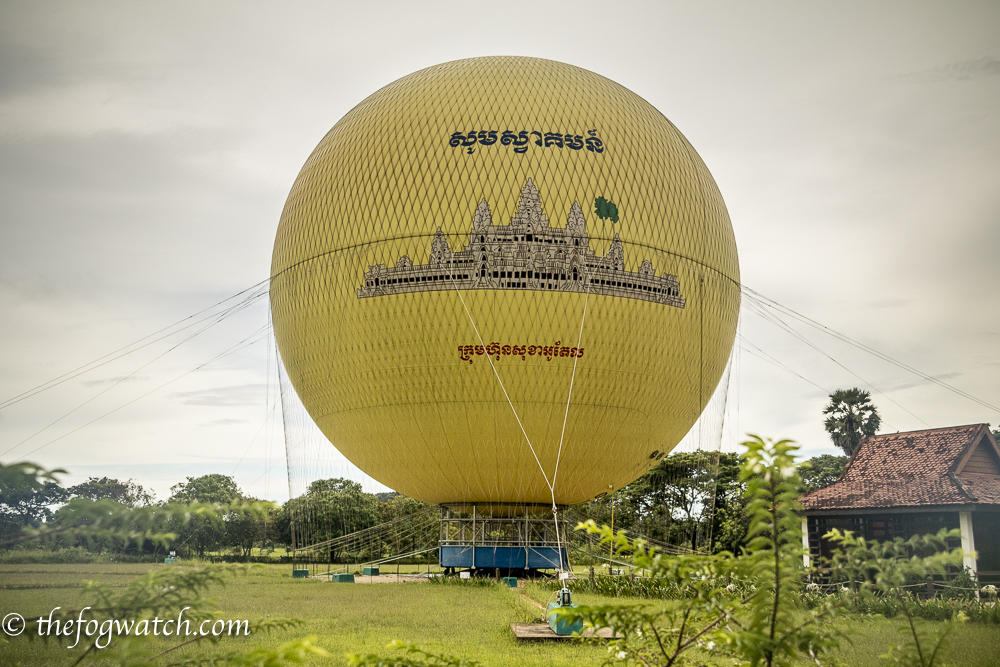
One of the striking things about Angkor Wat is the control of water through large-scale hydrological works around the complex. The ponds or moat around the Angkor temple complex is over 200m wide and was designed to reduce local flooding in the wet season. The scale of the hydrological works has to be seen to be believed, and considering this would have been dug by hand, it is very impressive indeed.

Today the main causeway is becoming fragile from the hundreds of thousands of annual visitors, so we are directed towards a floating causeway or pontoon bridge (see on the right in the photo above). It feels a little like walking on a bouncing castle, but it is stable, new and well maintained.
But not all of the ‘King’s swimming pool’ as the locals call it, remains in good repair – and there is evidence that its effectiveness decreased over centuries as it silted up, and was not regularly maintained even in its heyday. Today the locals and tourists use it as a picnic spot, and a cool place to watch the sunset.
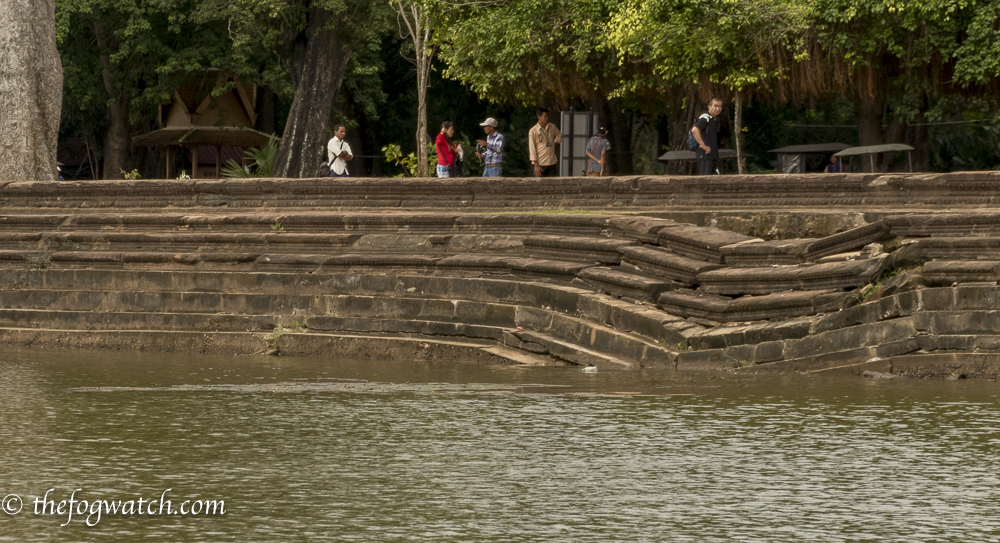
You first see the familiar beehive cupolas after you pass through the gates, and realise that this is a very large complex with many buildings, each with their attractions. This view is from one of the side temples, and is out of the way of the main crowds that head straight down the main causeway toward the iconic temple.
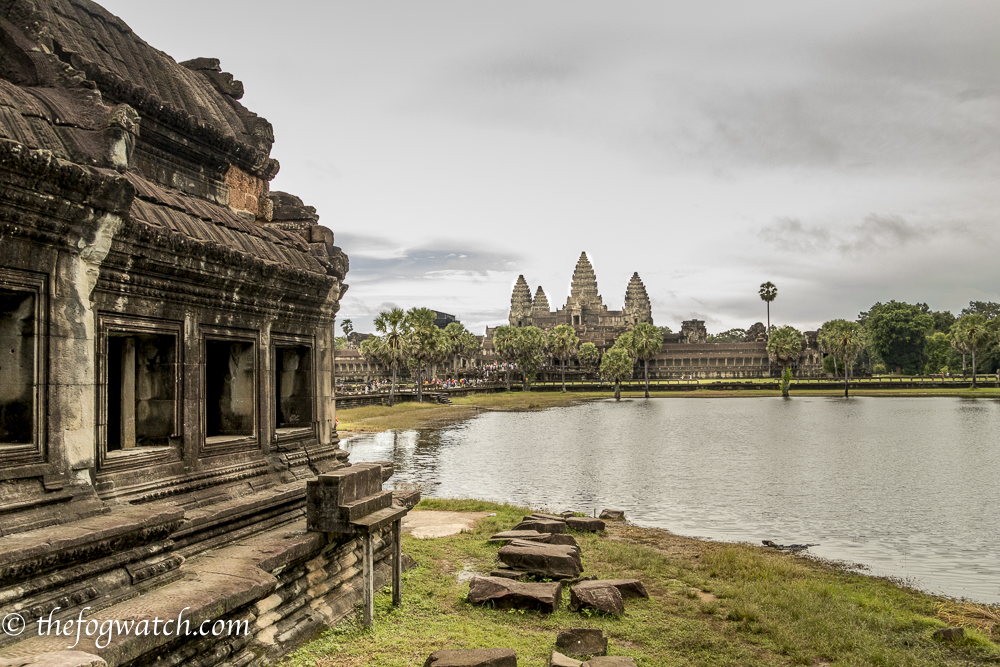
As I came closer I found a quiet spot to take in the view

Sometimes a sketch is the best way to understand a place, as you take time to observe, unlike the busloads of tourists that try to cram in this and three other temples into one day (!). Although this sketch was done from a photo afterwards, I did sketch in many of the temples during this visit.
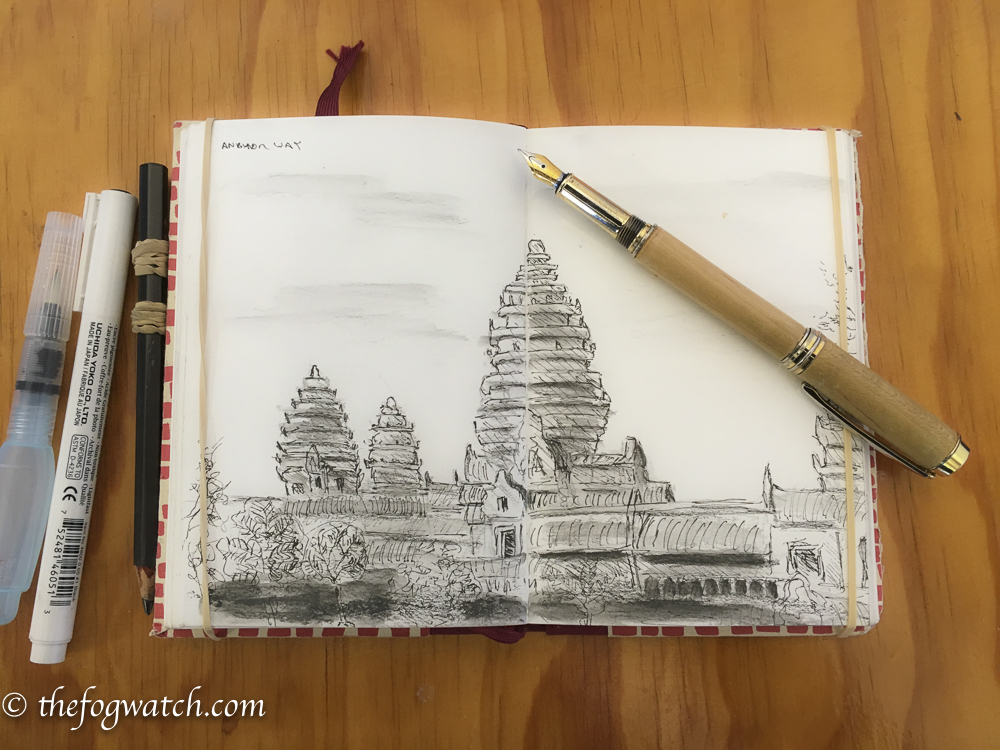
But there is so much to take in. One aspect for which Angkor Wat is particularly known, is the extensive wall carvings depicting scenes from King Suryavarman II’s life and from the sacred Hindu texts of the Ramayana and the Mahabharata. The depictions of war elephants and sophisticated chariots, as well as infantry each with their individual expressions, is worth a visit just for this.
The temple was dedicated by Suryavarman II to the Hindu god Vishnu, and there are gruesome depictions of tortures inflicted upon sinners in no less than 32 specialised hells. There are also depictions of the birth of the universe achieved through the Churning of the Ocean of Milk – the Earth is said to have been created from the resulting curd. It gives a whole new perspective on the moon being a piece of cheese!
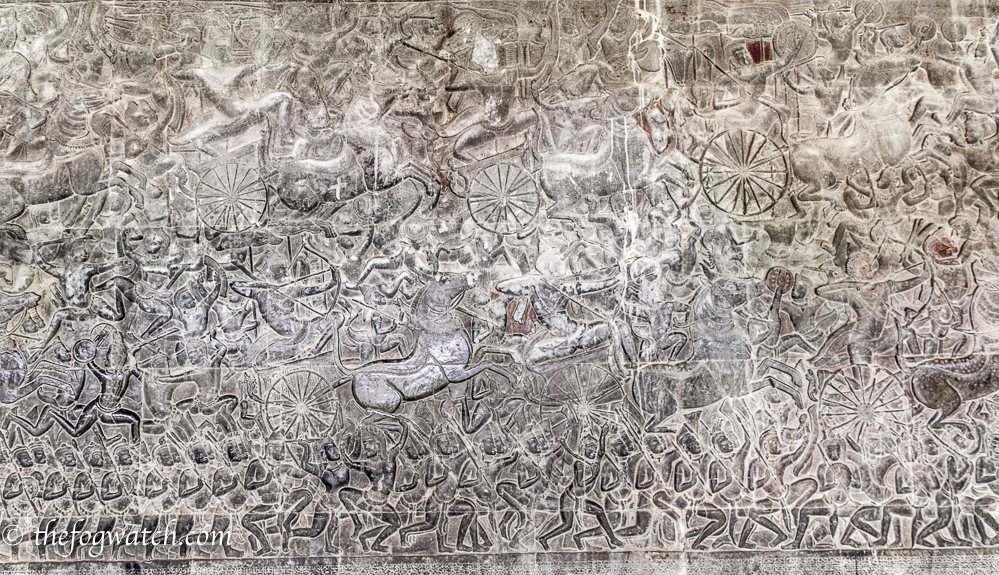
The windows are barred with stone balusters shaped in the form of prayer wheels – they are worn quite smooth in places, from countless hands running along them. They also make great silhouettes against the glare of the outside gardens.
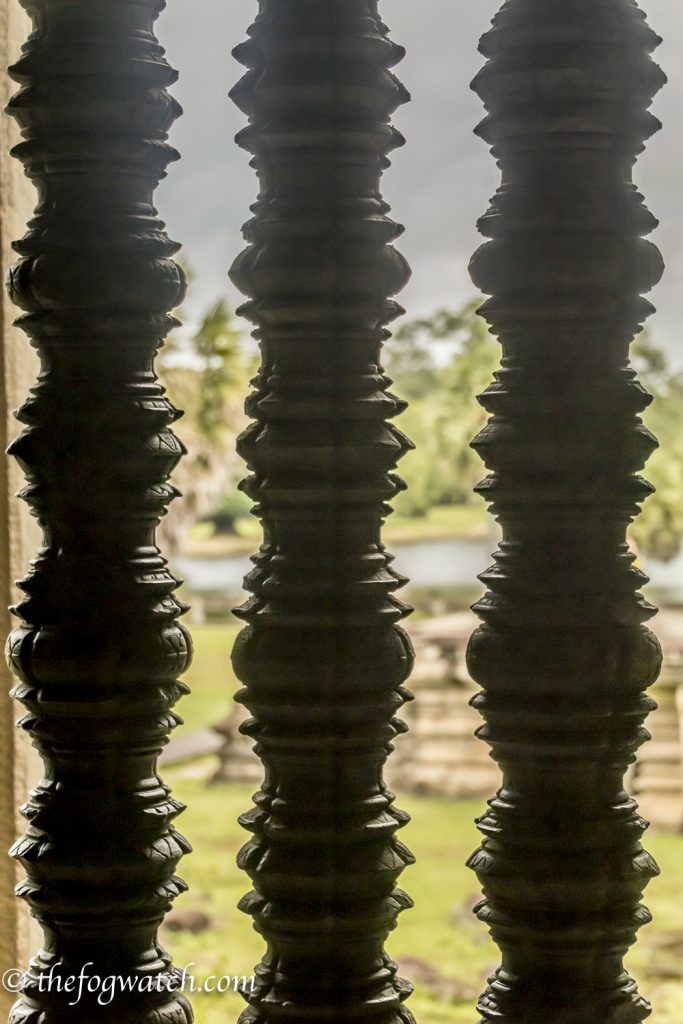
The buildings and corridors are clearly formed from corbelled arches, and you can see how the final key-stones keep the roof in place. It evidently works as most of these buildings have survived relatively intact for centuries.
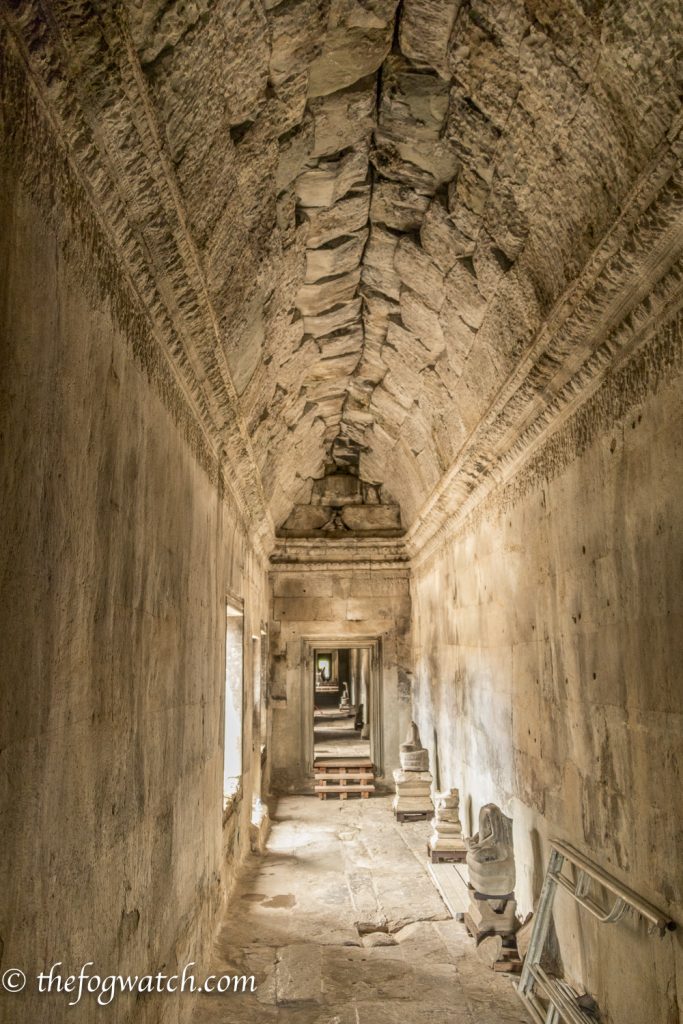
A special meeting
I was privileged to meet these two Buddhist monks.They spoke quite good English, so I asked if they were from the temple here, and they said they had come from another temple about 100kms away, to be here on a holy day. They have been monks for 18 years and they had a wonderful calm presence to them. I told them about my pilgrimage to Santiago de Compostela, and they seemed surprised that modern Westerners would undertake such a journey on foot. They were relaxed and joked around a little. I asked if they would mind having their photo taken, and they readily agreed – it is always polite to ask. As they sat, I moved up the nearby steps to take a different angle. I thanked them for talking with me and took my leave of them.

The central temple was closed to tourists for a Cambodian Hindu holy day (Pchum Ben – Ancestors Day), so we couldn’t get to the highest point, but of course, as a working temple, it is important to respect the place and its function. As someone once said: “Buddha (or Vishnu) is not a garden decoration.”
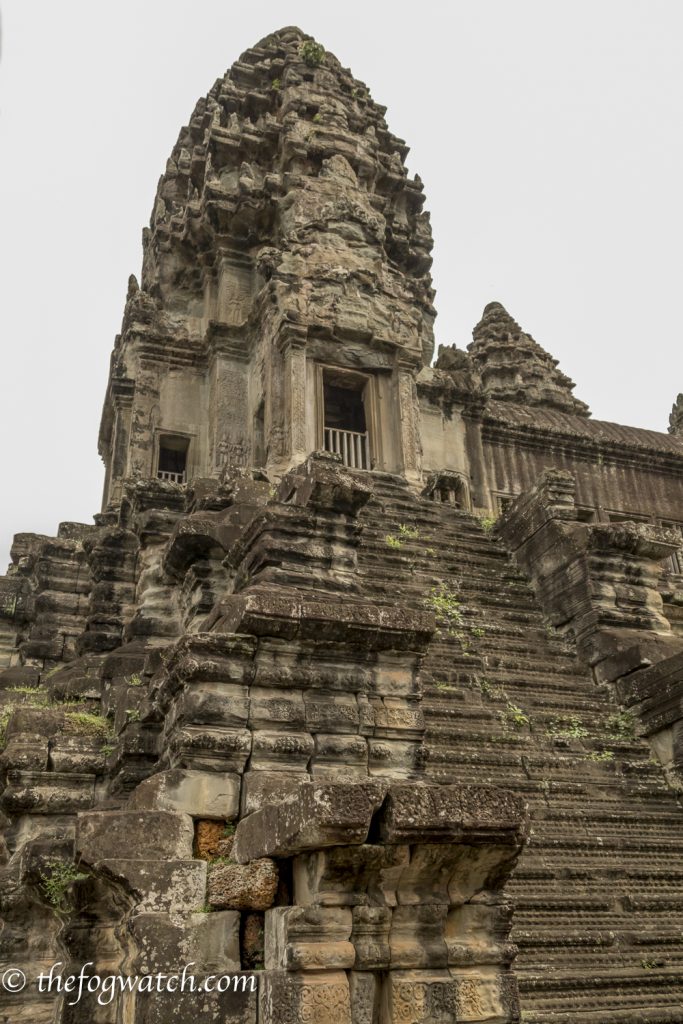
The processional corridors and cloisters are impressive. Of course, even the officials need to look after their feet sometimes…

Angkor Wat is also a popular place for film-makers and for professional fashion photographic shoots. This was in one of the side temples – the Southern pavilion.
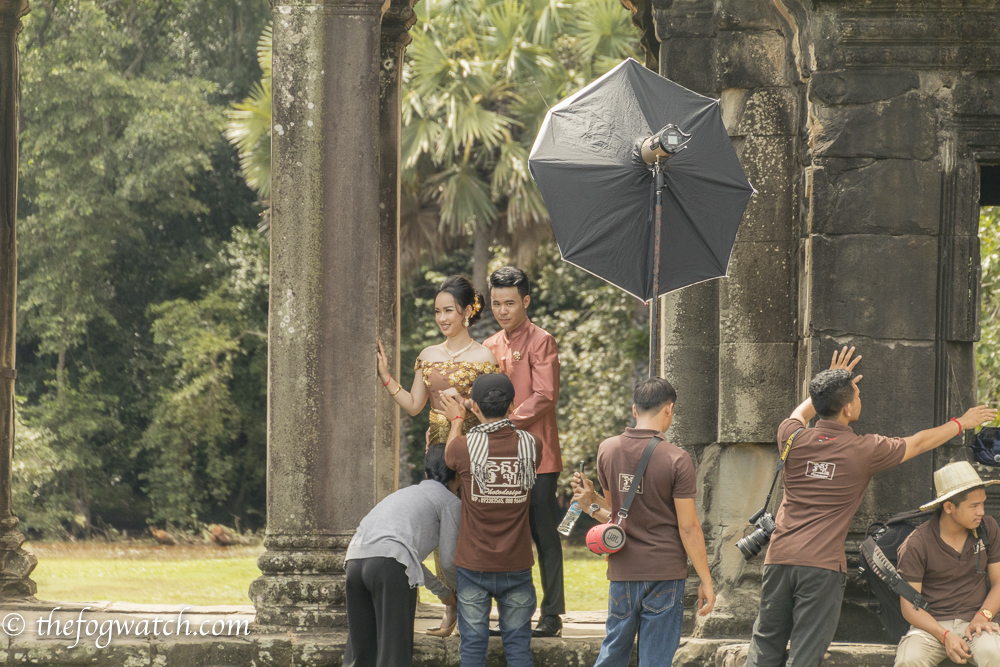
And of course, I had to get the ‘postcard’ shot – though it took a bit of doing. I initially tried to follow the lesser path to one side of the temple complex, but found the path flooded and quite muddy. So with wet feet, I headed back around and onto the main causeway, and then detoured to one of the side temples. Fortunately, I had remembered to bring a neutral density filter, as well as a circular polariser and, by holding the camera firmly against a wall I was able to get this shot. I was fortunate that the wind had died down ahead of the approaching rain.
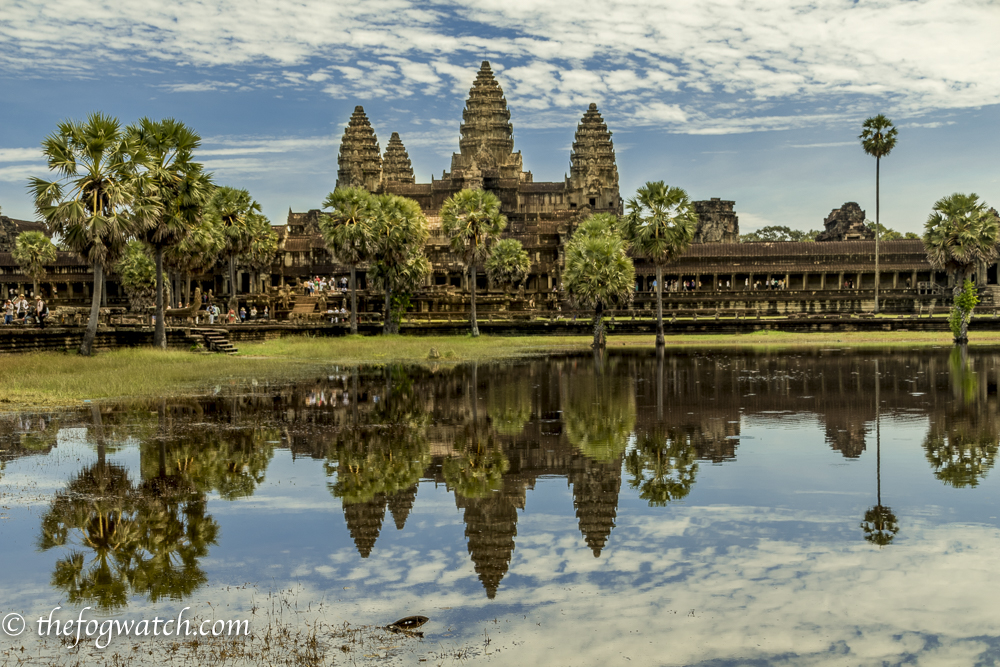
Once our friends had finished their sketches, we took our leave, knowing there is so much more to see here.
So, from a 12th century king who marshalled the control of water, to create a great civilisation, and who brought prosperity to his kingdom by regulating the worst ravages of the monsoon, to a temple dedicated to Vishnu, who churned the great Ocean of Milk to bring forth the Earth from the star-stuff of Space, we, now, in the 21st century are able to gaze on these wonders. It is worth taking the time, not just to see the buildings, but to see the system that made it possible, and gain a new respect for these achievements done without mechanisation, as we retreat back to our airconditioned hotel room, hoping for a strong wifi signal.
About Angkor Wat
The complex was built by King Suryavaman II in the first half of the 12th century. The temple complex, including the moats, covers an area of more than two square kilometres. As part of the King’s capital city, there is evidence of a major population centre throughout the surrounding area. This was enabled by the large Barays or reservoirs that mitigated the impact of the monsoonal variations in water level, and allowed for sustained irrigated agriculture through a sophisticated system of canals and channels. Not bad when you consider that Britain was still in the iron age, and Britain was seeing the end of Saxon rule. By the 13th century, the vast water management system covered an area of over 1000 square kilometres.
The Khmer rulers reigned here until the 15th century, leaving behind an amazing legacy of temples built to house Hindu and Buddhist divinities.
At a glance
Date: First half of the 12th century (around 1150)
King: Suryavarman II
Cult: Hindu (Vishnu)
Best seen: early morning or lunchtime when the tourist crowds are thinner. Also, try walking around away from the South Gate via the side temples once you cross the moat from the ticket control.
Do not miss: the carved relief panels – some of the best decorations in all the Khmer temples, and the view of the temple from the reflecting pools
Cost: One day pass is USD $37, three day pass is USD $62 and a seven day pass (recommended) is USD$72. The pass gets you into almost all the temples, not just Angkor Wat.
Location: around 7km north of Siem Ream city.
________________________________________
Why not have these posts delivered to your in-box? Just enter your email address and click the ‘subscribe’ button in the left margin, and don’t forget to respond to the confirmation email in your in-box 🙂 And of course ‘like’, share and subscribe using the buttons below!
________________________________________

Wonderful report, thank you, Jerry. And I smiled at „the hope of strong Wifi signal“ – it is our time!
Thanks Anneliese – yes truly a sign of our time – but one that allows us to share so much across the world and regardless of language 🙂